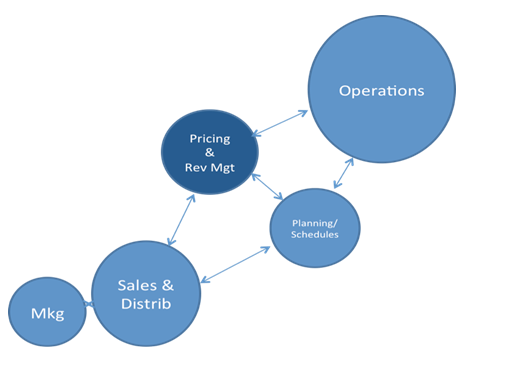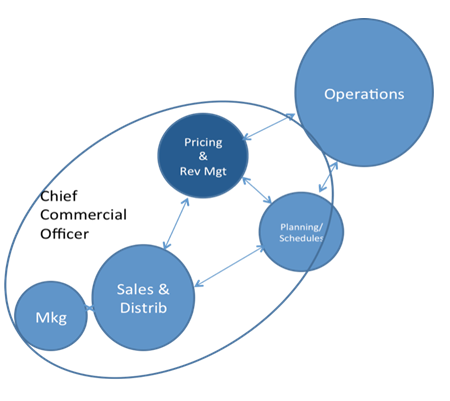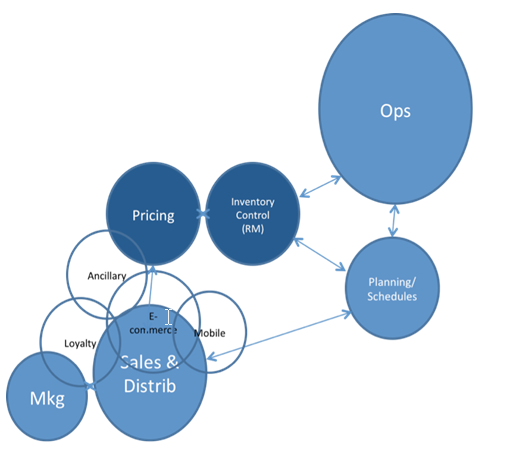Rethinking the organisation of revenue management: time for a fresh look
Jan 23, 2014


 comments powered by Disqus
comments powered by Disqus
RM is changing and now needs to work consistently across all business functions, but what is the best approach? Tom Bacon shares his views
RM is changing and now needs to work consistently across all business functions, but what is the best approach? Tom Bacon shares his views
Where does RM belong in my organisation? Should it be in the sales department or perhaps in planning? Or should it be a separate and distinct department? Sound familiar? Well you are not alone; these are frequently asked questions of revenue management.
The two largest functions in an airline in terms of number of employees tend to be in sales/marketing/distribution and operations. Like airline planning, revenue management tends to have far fewer employees yet it has important interactions with these two main departments. Here is how:
Operations: RM drives load factors and over sales. It also decides whether most of the passengers on a particular flight will be point-to-point or connecting to other flights (with implications for passenger and bag handling).
Sales, Marketing & Distribution: Pricing/RM set all fares, including corporate and group fares. Pricing/RM sets the rules, which sales must follow. Also, marketing is often deployed around promotional fare sales.
Like RM, planning is a highly analytical department. Fleet planning, route planning, and schedules established by the planning department are also key to RM’s revenue optimisation algorithms.
Revenue management’s organisational positioning

When I was at American Airlines, RM was initially in the same larger organisation as sales, and separate from planning and operations. This had the following implications:
• It meant that the two key analytical centres of the company namely RM and planning, were effectively competitors. Often each deployed their brain trusts to separately address key revenue problems. This organisational solution changed after one of the corporate streamlining initiatives. In the new organisation, RM and planning were combined under one executive VP and separated from sales, marketing, and distribution.
• It eliminated some of the redundancy inherent in separating the key analytical functions. RM and the planning resource could be deployed to the issues best suited to each.
• Although the two functions were still separate – and led by strong independent leaders – this organisational solution comes closer to establishing a corporate analytical centre of excellence.
• This organisational structure also recognises the different goals of RM versus sales. Sales is generally more interested in corporate customer relationships and overall sales volume, while RM must allocate scarce capacity across all market segments and balance volume with rate.
Even more recently, American combined pricing/RM; sales, marketing & distribution; and planning all under one chief commercial officer. This made one EVP responsible for all revenue-related functions of the airline.
Revenue Management and the chief commercial officer

In my view, this is a terrific solution since RM must obviously work closely with each of these other departments and its strategies should be integrated and consistent across functions.
The problem now is that both pricing/RM and sales/distribution have changed dramatically over the past five years – and new important functions have appeared with significant overlap. So, as 2014 begins, it may be useful to take a fresh look at your organisational structure and ensure it is set up for the changing marketplace. How, for example, does your organisational structure support pricing/RM’s interaction with each of the following?
Ancillary: Ancillary is a pricing function, an RM responsibility, but also a new merchandising/distribution opportunity. Revenue management cannot be separated from ancillary – instead, RM must adopt a new ‘total revenue management’ approach that incorporates ancillary revenue directly into its revenue optimisation routines. Spirit Airlines, a US-based leader in ancillary, has a corporate goal to increase total revenue while reducing the base fare – yet, historically, airline RM has focused on just maximising the base fare.
e-commerce: Ancillary in turn changes the online distribution game. No longer can you just simply make your products available via your company website – you need to capitalise on the new upsell opportunities of ancillary through online merchandising. Effectively, ‘total revenue management’ includes online merchandising.
Mobile: Mobile is a subset of e-commerce - but it also offers unique revenue opportunities. Mobile affords greater opportunity for close-in bookings, new opportunities for upsell at the last minute, and new customer engagement.
Loyalty/customer: Another implication of the new ancillary fee structure is new opportunities for personalisation/customisation. Airlines have historically focused their CRM efforts on frequent flyers and their most loyal passengers. However, with ancillary, analytics needs to be applied to offering ‘the right product at the right price at the right time’ to additional customer segments.
Revenue management’s new organisational links

So, now RM has become even more linked to distribution through ancillary fees. And, due to new merchandising opportunities, RM is tied to both e-commerce and mobile. Ancillary also means new customisation beyond what loyalty does today. But do all of these functions need to report to one executive to ensure coordination and optimisation?
At Frontier Airlines, RM and planning were combined under me while sales, marketing and distribution (including loyalty and e-commerce) was a separate organisation. However, we benefited from having a very small organisation – a total of 35 people across all these revenue-related functions and all were co-located in the same office. My office was right next to the executive in charge of all of the other revenue functions. And typically only one layer of management existed between the lowest level and the vice president level. In addition, we were extremely aligned in terms of departmental goals:
• As a carrier in bankruptcy during the economic crisis, we were collectively very focused on short-term revenue per ASM. We monitored daily cash inflow from sales in order to survive.
• We also had a joint project that cut across most of the individual revenue responsibilities – ‘branded Fares’. To be the first airline to introduce ‘branded fares’ in the US, we needed RM, pricing, distribution, e-commerce, and ancillary to work closely together.
Each of the new functions has its unique perspective – and unique revenue opportunities – but none of them are large in terms of employees. None of them should be buried deep in a much larger organisation like sales, marketing and distribution. Although they may not fit in your RM organisation, ensure ancillary, e-commerce, mobile and alliances each have few layers separating them from the officer level – and all ultimately need to report up to the same executive whether it is the chief commercial officer or the head of revenue (sales, marketing, distribution and RM).
Of course, with all of the new overlap, no organisational structure will be perfect. Therefore, your company needs to employ as many other integrating mechanisms as possible. This could include shared reports, metrics, regular joint meetings and cross-functional project-oriented teams. Even at Frontier, with its small revenue-related organisation, we deployed all of these mechanisms to keep RM, sales/marketing/distribution, ancillary, e-commerce, and mobile all working together.
In 2014, it is time to take a new look at your organisational solution for RM and its relation to other departments. Much has changed in the past five years – new functions, new opportunities – that your organisation needs to be positioned to capitalise on in the New Year.
This guest article was penned by Tom Bacon, 25-year airline veteran and industry consultant in revenue optimisation. Questions? Contact Tom at tom.bacon@yahoo.com or visit his website http://makeairlineprofitssoar.wordpress.com/

